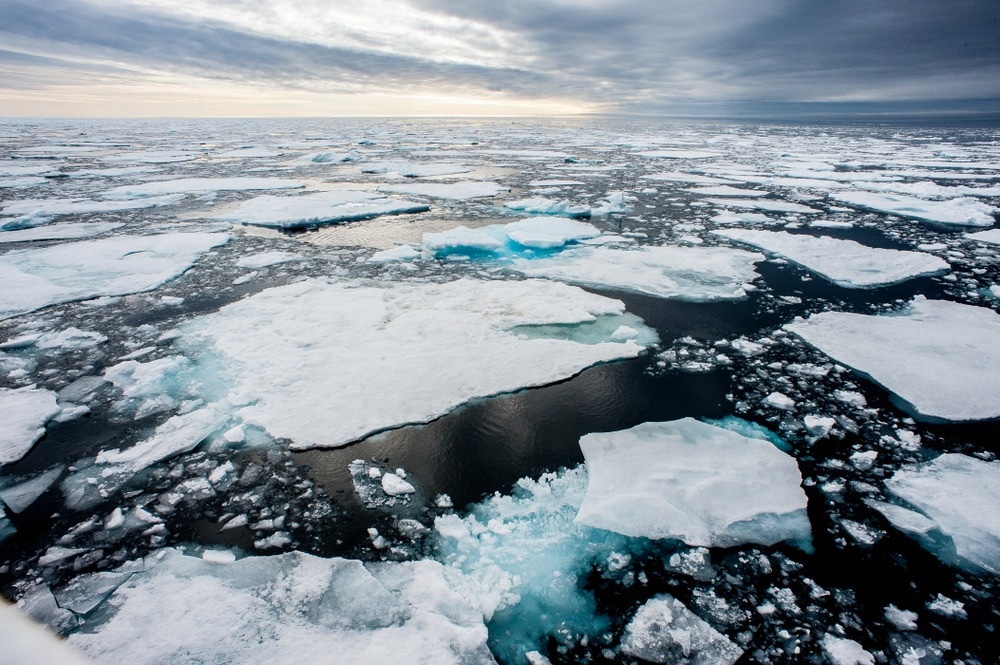According to recent research, Antarctic ice shelves have had very moderate increases in surface melt rates over the last four decades, in contrast to Greenland’s glaciers, which experienced a fast increase in surface melt during the same time period. However, the investigators do not expect Antarctic ice shelf surface melt rates to grow much in the next decades due to rising global air temperatures.

Image Credit: Tony Skerl/Shutterstock.com
Ice shelves are glacier extensions that extend into the ocean and float on top of the water. Glaciologists used satellite microwave data and computer modeling in a new study published today in Geophysical Research Letters to calculate how much surface melt happened on all Antarctic ice shelves from 1980 to 2021.
Alison Banwell, a Glaciologist at the Cooperative Institute for Research in Environmental Sciences (CIRES), a collaboration between the University of Colorado Boulder and the National Oceanic and Atmospheric Administration, guided the study.
The results demonstrate that surface melt rates on Antarctic ice shelves have changed only slightly over the last 40 years, and the modeling results show a small but significant drop in melt rates during the study period.
However, several ice shelves on the Antarctic Peninsula, which juts out of the continent toward South America, have experienced unusually high surface melt in recent years, particularly during the 2019–2020 Austral summer.
The results appear to be excellent news for the Antarctic region, but the scientists warn that they expect more surface melt on Antarctic ice shelves in the coming decades. Surface melting is not the only threat to ice shelves; researchers studying the Thwaites Ice Shelf in West Antarctica discovered that warm ocean water is eroding the fragile ice shelf from below.
As air temperatures increase over the coming decades, we're expecting a real increase in these surface melt rates up until the end of the century. So although we haven't seen much change in melt rates yet, we will see that to come. It just hasn't really kicked off yet.
Alison Banwell, Glaciologist, Cooperative Institute for Research in Environmental Sciences
Ice shelves help to keep upstream glaciers from flowing too quickly into the ocean, but they are vulnerable to surface melting and melting from warm ocean water below.
The polar areas are more susceptible to warming temperatures, and experts have observed significant melt on Greenland’s ice sheet in recent decades, but Antarctica’s response to climate change has differed. Some parts of the continent, such as the Antarctic Peninsula, have warmed significantly, but the other two have not.
Banwell chose to look at all of Antarctica’s ice shelves to examine how (and if) they have altered over the past 40 years after researching the surface melt of one Antarctic ice shelf from 1980 to 2021.
Her current study is the first to use satellite microwave data in conjunction with a computer model to measure surface melt across the entire continent’s ice shelves. The satellite data showed how many days each ice shelf had meltwater, whereas the computer model approximated the volume of meltwater produced each day when meltwater was present.
According to the model employed by the researchers, the Antarctic ice shelves had little change in surface melt during the last four decades, and there was even a modest but significant drop in surface melt. The researchers do anticipate an increase in surface melt in the future decades. Surface melt weakens ice shelves by thinning them and altering their response to stress.
As temperatures increase…melt rates will rise, ice shelves are going to become much less stable as decades go on by the end of the century.
Alison Banwell, Glaciologist, Cooperative Institute for Research in Environmental Sciences
Journal Reference:
Banwell, A. F., et al. (2023) Quantifying Antarctic-Wide Ice-Shelf Surface Melt Volume Using Microwave and Firn Model Data: 1980 to 2021. Geophysical Research Letters. doi.org/10.1029/2023GL102744.